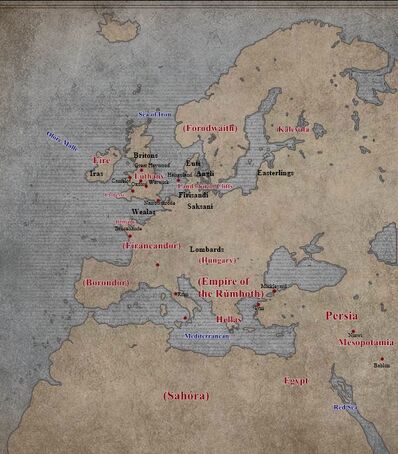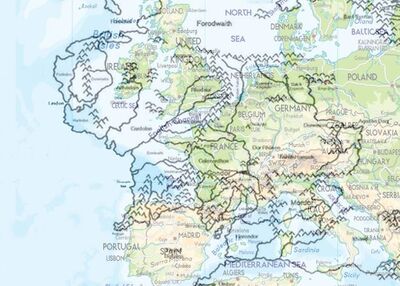
The Sixth Age of Arda refers to our historical world from the early history until the Second World War (referred to as "the Six Years War" in The Notion Club Papers).
Notable events of the Sixth Age
- 2340 BC - The Great Flood.
- 2340 BC - Irish legend of Tuatha-de-Danaan and Tuan Mac Cairill the oldest man in the world
- 1190 BC - The Fall of Troy. Aeneas flees to Italy and builds a village alongside the Tiber River.
- 753 BC - The twins Romulus and Remus build a fortified town at the site of Aeneas's settlement, Rome (known to the Elves as Rum).
- 428-347 BC - The Hellenic Philospher Platon writes down ancient tales and legends about Atlantis
- 55 BC - The last Elves of Luthany flee to Tol Eressea. Ing is driven east over the sea by Ossë and becomes ruler of a proto-Germanic tribe. Possible inspiration of the legend of King Sheave.
- 4 BC - Illuvatar enters his own creation Ea and incarnates in the Hroa of a Hildo.
- History of Audoin, king of the Lombards, and his son Alboin
- 6th century AD - Arthur reigns in Camelot as King of the Britons; after his death, his body is said to rest in Avalon, the latter-day name of Tol Eressea. Bréanainn of Clonfert embarks on an imram, or sea journey, recorded in the epic poem, The Voyage of Saint Brendan; he has visions of Meneltarma and the White Tree of Tol Eressea.
- 8th-10th century AD - Legend of King Sheave
- 918 AD - Ælfwine of England travels to Tol Eressea. He meets many Elves in the Cottage of Lost Play, where he translates the Golden Book of Tavrobel into Anglo-Saxon before returning to England.
- 11th century AD - The village of Narrowthrode in England is founded by Norman invaders, named after Nargothrond as described in Ælfwine's writings. It later becomes a center of learning.
- 18th century AD - Academic study of The Lay of Leithian (or The Geste of Beren and Lúthien) becomes a subject of renewed interest. Notable writers on the subject include Peabody, Pumpernickel, Bentley, and the authors of the Gestestudien, Schuffer and Schick.
- 1892 AD - Alboin Errol born in England. J.R.R. Tolkien born in South Africa.
- 1917 AD - J.R.R. Tolkien begins his translations of the Golden Book of Tavrobel and the Red Book of Westmarch into modern English.
- 1918 AD - Audoin Errol born to his father Alboin.
- 1925 AD - J.R.R. Tolkien translates The Lay of Leithian into modern English. His colleague C.S. Lewis publishes an essay on the history of the poem and its criticism.
- 1929 AD - Michael Ramer born in Hungary.
- 1934 AD - Alboin Errol and his son Audoin experience visions of the distant past, effectively traveling back in time to Numenor in the time of Elendil, Ælfwine's England, and other points at which their ancestors (possibly earlier incarnations) played important parts in history. They die under mysterious circumstances.
- 1936 AD - The Hobbit, a novelization of the memoirs of Bilbo Baggins, is published by J.R.R. Tolkien. It meets with only modest success.
- 1938 AD - Out of the Silent Planet is published by C.S. Lewis; the book has a strong impact on several members of the Notion Club years later. Alwin Arundel Lowdham born in England.
- 1939 AD - The beginning of the Six Years War between Britain and Germany.
- 1942 AD - William Trewin Jeremy born in England.
- 1945 AD - The Six Years War comes to an end, marking the end of the old order of imperial powers and the beginning of a new age of technology. End of the Sixth Age.
Men of the Sixth Age
Ælfheah ‘the fatherless’ Ælfwine of England Aeneas Alboin King of the Lombards Alboin Errol Alexander Cameron Alwin Arundel Lowdham Arundel Lowdham Audoin King of the Lombards Audoin Errol Bentley Beorn Bior of the Ythlings Ceola of Somerset Céolwulf Colombo Arditi C.S. Lewis Cwén Déor D.N. Borrow Dom Jonathan Markison Dr. Abel Pitt Éadgifu of Lionesse Eädwine Edwin Lowdham Eoh Eriol Eruamillë Finntann the oldest man Geraint of West Wales Heden the leather and fur clad Hengest Heorrenda Horsa Howard Green James Jones of Oxford J.R. Titmass J.R.R. Tolkien John Jethro Rashbold King Arthur King Sheave Michael George Ramer Nicholas Guildford Norman Keeps Old Professor Rashbold Orm Oswin Errol Oswin Lowdham Óswine Prince of Gwar Ottor Peabody Philip Frankley Platon Pumpernickel Queen Elizabeth I of England Queen Elizabeth II of the United Kingdom Ranulph Stainer Remus Romulus Rosamunda Rupert Dolbear Sir Gerald Manface Tréowine W.W. Wormald Wilfred Trewin Jeremy
Middle-Earth and modern Day Europe

The Westlands of Middle-Earth in comparison to modern Europe
Tolkien intended Middle-Earth, or the Westlands, to correspond to Europe but set in a fictional prehistoric Age. He even gave hints that he intended Minas Tirith to be set on the same degree of latitude as Florence and Hobbiton and Rivendell to lay on the same latitude as Oxford. However he never gave informations on any degree of longitude, but these could eventually be guessed by taking his early maps of Beleriand into account. His sketches in the Shaping of Middle-Earth show the northwestern Coasts of Beleriand to be parallel with the west coast of North Africa, taking into account that Beleriand measured roughly 600 miles in longitude, this would set the Nenuial approximately on the same degree of longitude as Dublin. On the other hand, in his early writings, Tolkien had concipated Great Britain and Ireland to be remnants of eastern Tol Eressëa which had broken off the greater part of the island and remained in the east after Ulmo had transferred the rest of the Island into the Bay of Eldamar. Concerning this, the progenitor of the later British Isles must have been part of an archipelago which lay west of the Ered Luin close to the remains of the Bay of Balar and ancient Beleriand, which would place the coast of Lindon at least between the 0 and 10 degree of longitude.
